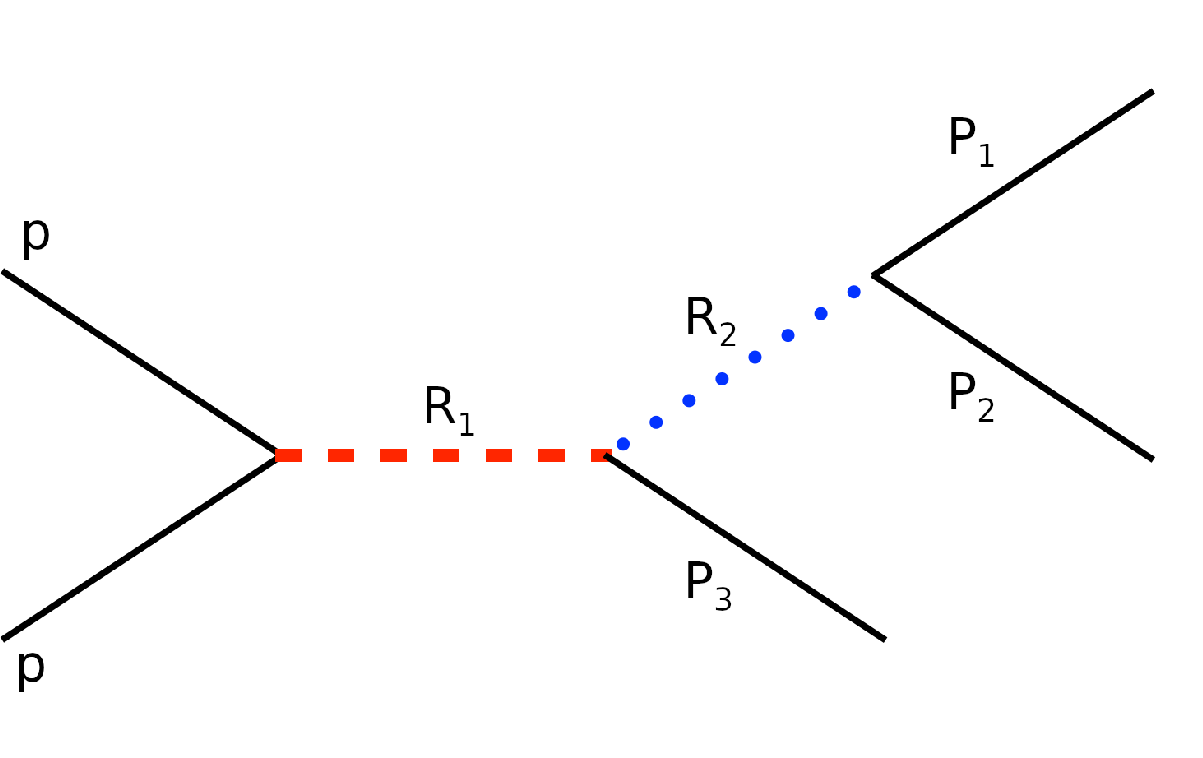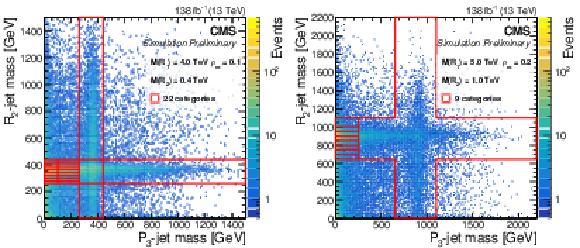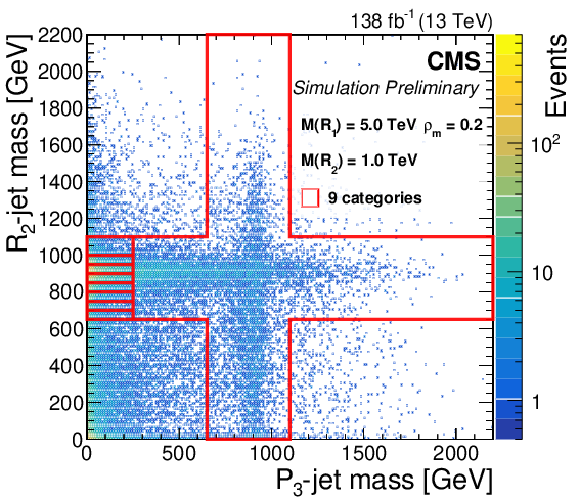

Compact Muon Solenoid
LHC, CERN
| CMS-PAS-EXO-20-007 | ||
| Search for high mass trijet resonances using final states with boosted dijet resonances in proton-proton collisions at √s= 13 TeV | ||
| CMS Collaboration | ||
| June 2021 | ||
| Abstract: A novel search is reported for high mass trijet resonances that decay to a jet and a boosted dijet resonance. The search uses 138 fb−1 of integrated luminosity collected by the CMS detector in proton-proton collisions at √s= 13 TeV. The boosted dijet resonance is reconstructed as a single jet, containing jet substructure consistent with a two-body decay. The jet substructure information and the kinematics of cascade resonance decays are exploited to disentangle the signal from the large QCD multijet background. The dijet mass spectra are analyzed for the presence of new resonances, and are found to be consistent with standard model expectations. Results are interpreted in a warped extra dimension model where the first resonance is a Kaluza-Klein (KK) gluon, the second resonance is a radion, and final state partons are all gluons. Limits on the production cross section are set as a function of KK gluon and radion masses. These limits exclude at 95% confidence level a KK gluon with a mass of 4.2TeV for a radion mass of 0.42 TeV, and a radion with a mass of 0.74 TeV for a KK gluon mass of 3.7 TeV. By exploring a novel experimental signature, we extend significantly the discovery potential of this benchmark model of new physics compared to previous searches at the LHC. | ||
|
Links:
CDS record (PDF) ;
inSPIRE record ;
CADI line (restricted) ;
These preliminary results are superseded in this paper, Submitted to PLB. The superseded preliminary plots can be found here. |
||
| Figures | |

png pdf |
Figure 1:
Feynam diagram of the process pp→R1→R2+P3→(P1+P2)+P3 involving the cascade decays of two new massive resonances. The particles in the final state are partons (quarks, antiquarks or gluons). |

png pdf |
Figure 2:
Left) Simulation of the second resonance vs the parton candidate masses (points), for trijet resonance events originating from a KK gluon with a mass MGKK= 4 TeV, decaying to a radion with a mass Mϕ= 0.4 TeV and a gluon. The 22 event categories in this plane, within which the search in the dijet mass distribution is conducted, are shown with red boxes. Right) Same for MGKK= 5 TeV, and Mϕ= 1 TeV , for which the number of event categories is 9. For both plots, the cross-like shape is approximately centered on the second resonance pole mass M(R2) for both horizontal and vertical axes. |

png pdf |
Figure 2-a:
Left) Simulation of the second resonance vs the parton candidate masses (points), for trijet resonance events originating from a KK gluon with a mass MGKK= 4 TeV, decaying to a radion with a mass Mϕ= 0.4 TeV and a gluon. The 22 event categories in this plane, within which the search in the dijet mass distribution is conducted, are shown with red boxes. Right) Same for MGKK= 5 TeV, and Mϕ= 1 TeV , for which the number of event categories is 9. For both plots, the cross-like shape is approximately centered on the second resonance pole mass M(R2) for both horizontal and vertical axes. |

png pdf |
Figure 2-b:
Left) Simulation of the second resonance vs the parton candidate masses (points), for trijet resonance events originating from a KK gluon with a mass MGKK= 4 TeV, decaying to a radion with a mass Mϕ= 0.4 TeV and a gluon. The 22 event categories in this plane, within which the search in the dijet mass distribution is conducted, are shown with red boxes. Right) Same for MGKK= 5 TeV, and Mϕ= 1 TeV , for which the number of event categories is 9. For both plots, the cross-like shape is approximately centered on the second resonance pole mass M(R2) for both horizontal and vertical axes. |

png pdf |
Figure 3:
Weighted sum of the number of events divided by bin width within each category as a function of dijet mass (points) for the search for a trijet resonance with mass MR1=MGKK=2.9TeV decaying to a second resonance with mass MR2=Mϕ= 0.4 TeV (ρm∼ 0.14) and a parton. The weights are the expected signal event fractions for each category, assuming a signal cross section equal to the 95% CL upper limit. Also shown is the same quantity from the background-only fits in each category (solid histogram), with statistical uncertainty (hatched), and from the signal normalized to the upper limit (dashed histogram). The lower panel shows the difference between the data and the background prediction divided by the statistical uncertainty of the background (solid red), and the same quantity for the signal (dashed). |

png pdf |
Figure 4:
Observed upper limits on signal cross section, as a function of the ratio of the two resonance masses versus the first resonance mass, for a trijet resonance model with 3 gluons in the final state. The excluded regions from this search, optimized for the GKK→ϕ+g→ggg decay, are compared with those obtained from a reinterpretation of the inclusive CMS dijet resonance search [1], sensitive to the GKK→qˉq decay. |
| Summary |
| In summary, a novel search for new high mass hadronic resonances, that decay to a parton and a second resonance, that in turn decays into a pair of partons, has been presented. This is the first dedicated search for trijet resonances at the LHC in events with a boosted dijet. No statistically significant excesses above the background predictions are observed. Results are interpreted in a warped extra dimension model where the first resonance is a Kaluza-Klein gluon, the second one is a radion, and the final state partons are all gluons. By exploring a novel experimental signature, we extend significantly the experimental exclusion of this benchmark model of new physics at the LHC. |
| References | ||||
| 1 | CMS Collaboration | Search for high mass dijet resonances with a new background prediction method in proton-proton collisions at √s= 13 TeV | JHEP 05 (2020) 033 | CMS-EXO-19-012 1911.03947 |
| 2 | CMS Collaboration | Search for pair-produced resonances decaying to quark pairs in proton-proton collisions at √s= 13 TeV | PRD 98 (2018) 112014 | CMS-EXO-17-021 1808.03124 |
| 3 | CMS Collaboration | Search for pair-produced three-jet resonances in proton-proton collisions at √s= 13 TeV | PRD 99 (2019) 012010 | CMS-EXO-17-030 1810.10092 |
| 4 | M. Redi, V. Sanz, M. de Vries, and A. Weiler | Strong Signatures of Right-Handed Compositeness | JHEP 08 (2013) 008 | 1305.3818 |
| 5 | K. S. Agashe et al. | LHC Signals from Cascade Decays of Warped Vector Resonances | JHEP 05 (2017) 078 | 1612.00047 |
| 6 | ATLAS Collaboration | Search for new resonances in mass distributions of jet pairs using 139 fb−1 of pp collisions at √s= 13 TeV with the ATLAS detector | JHEP 03 (2020) 145 | 1910.08447 |
| 7 | Alwall, J. and Frederix, R. and Frixione, S. and Hirschi, V. and Maltoni, F. and Mattelaer, O. and Shao, H.-S. and Stelzer, T. and Torrielli, P. and Zaro, M. | The automated computation of tree-level and next-to-leading order differential cross sections, and their matching to parton shower simulations | JHEP 07 (2014) 079 | 1405.0301 |
| 8 | CMS Collaboration | The CMS Experiment at the CERN LHC | JINST 3 (2008) S08004 | CMS-00-001 |
| 9 | CMS Collaboration | Particle-flow reconstruction and global event description with the CMS detector | JINST 12 (2017) P10003 | CMS-PRF-14-001 1706.04965 |
| 10 | M. Cacciari, G. P. Salam, and G. Soyez | FastJet User Manual | EPJC 72 (2012) 1896 | 1111.6097 |
| 11 | M. Cacciari, G. P. Salam, and G. Soyez | The anti-kt jet clustering algorithm | JHEP 04 (2008) 63 | 0802.1189 |
| 12 | D. Bertolini, P. Harris, M. Low, and N. Tran | Pileup Per Particle Identification | JHEP 10 (2014) 59 | 1407.6013 |
| 13 | CMS Collaboration | Jet algorithms performance in 13 TeV data | CMS-PAS-JME-16-003 | CMS-PAS-JME-16-003 |
| 14 | CMS Collaboration | The cms trigger system | JINST 12 (2017), no. 01, P01020 | |
| 15 | J. Thaler and K. Van Tilburg | Identifying Boosted Objects with N-subjettiness | JHEP 03 (2011) 015 | 1011.2268 |
| 16 | Roger Barlow | Event classification using weighting methods | J. Comp. Phys. 72 (1987) 202 | |
| 17 | T. Junk | Confidence level computation for combining searches with small statistics | Nucl. Instr. Meth. A 434 (1999) 435 | hep-ex/9902006 |
| 18 | A. L. Read | Presentation of search results: the CLs technique | JPG 28 (2002) 2693 | |
| 19 | G. Cowan, K. Cranmer, E. Gross, and O. Vitells | Asymptotic formulae for likelihood-based tests of new physics | EPJC 71 (2011) 1554 | 1007.1727 |
| 20 | LHC Higgs Combination Group | Procedure for the LHC Higgs boson search combination in Summer 2011 | CMS-NOTE-2011-005 | |

|
Compact Muon Solenoid LHC, CERN |

|

|

|

|

|

|